Advertisements
Advertisements
प्रश्न
Draw a p-V diagram of the irreversible process.
उत्तर
p-V diagram of the irreversible process:
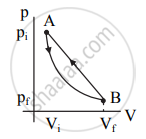
APPEARS IN
संबंधित प्रश्न
Give an example of some familiar process in which heat is added to an object, without changing its temperature.
For work done to be reversible, the process should be ______
Heating a gas in a constant volume container is an example of which process?
State the assumptions made for thermodynamic processes.
Differentiate between the reversible and irreversible processes.
Explain the cyclic process.
3 mole of a gas at temperature 400 K expands isothermally from an initial volume of 4 litres to a final volume of 8 litres. Find the work done by the gas. (R = 8.31 J mol-1 K-1)
An ideal gas of volume 2 L is adiabatically compressed to (1/10)th of its initial volume. Its initial pressure is 1.01 x 105 Pa, calculate the final pressure. (Given 𝛾 = 1.4)
Explain work done during a thermodynamic process.
Explain the thermodynamics of the isobaric process.
Explain the thermodynamics of the isochoric process.
When you exercise in the morning, by considering your body as a thermodynamic system, which of the following is true?
Apply first law for an isothermal process.
Apply first law for an adiabatic process.
Draw the PV diagram for the isobaric process.
Can the given heat energy be completely converted to work in a cyclic process? If not, when can the heat can completely converted to work?
Explain in detail an adiabatic process.
Explain the isobaric process and derive the work done in this process.
In a petrol engine, (internal combustion engine) air at atmospheric pressure and temperature of 20°C is compressed in the cylinder by the piston to `1/8` of its original volume. Calculate the temperature of the compressed air. (For air γ = 1.4)
Consider the following cyclic process consist of isotherm, isochoric and isobar which is given in the figure.
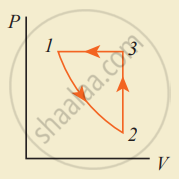
Draw the same cyclic process qualitatively in the V-T diagram where T is taken along the x-direction and V is taken along the y-direction. Analyze the nature of heat exchange in each process.
An ideal gas is taken in a cyclic process as shown in the figure. Calculate
- work done by the gas
- work done on the gas
- Net work done in the process

A thermodynamic system undergoes cyclic process ABCDA as shown in the figure. The work done by the system is ______

We consider a thermodynamic system. If `Delta"U"` represents the increase in its internal energy and W the work done by the system, which of the following statements is true?
Ideal gas for which 'ϒ' = 1.5 is suddenly compressed to `1/4`th of its initial volume. The ratio of 4 the final pressure to the initial pressure is ______.
`(ϒ = "C"_"p"/"C"_"v")`
Consider P-V diagram for an ideal gas shown in figure.
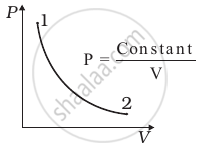
Out of the following diagrams (figure), which represents the T-P diagram?
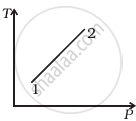 (i) |
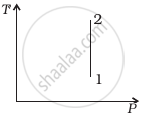 (ii) |
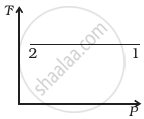 (iii) |
 (iv) |
In a certain thermodynamical process, the pressure of a gas depends on its volume as kV3. The work done when the temperature changes from 100°C to 300°C will be ______ nR, where n denotes number of moles of a gas.
When an inflated ballon is suddenly burst, why is the emerging air slightly cooled?
Explain how can a gas be expanded at constant temperature.
